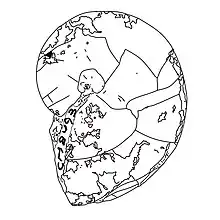Obinautilus
Obinautilus is an extinct genus of shelled cephalopod that has been variously identified as an argonautid octopod[3][4][5][6][7][8] or a nautilid.[1][9][10][11][12] It is known from the Late Oligocene to Pliocene of Japan.[4] The shell is discoidal and very involute, with rapidly expanding and compressed whorls, fine radial ribs, a rounded venter with a shallow furrow, and almost closed umbilicus.
| Obinautilus | |
|---|---|
 | |
| Obinautilus pulchra | |
| Scientific classification | |
| Domain: | Eukaryota |
| Kingdom: | Animalia |
| Phylum: | Mollusca |
| Class: | Cephalopoda |
| Order: | Octopoda |
| Family: | Argonautidae |
| Genus: | †Obinautilus Kobayashi, 1954[1] |
| Species | |
Based on the examination of O. pulcher fossils from the Oligocene, the Tremoctopus–Argonauta divergence has been estimated to have occurred at least 29 million years ago.[5]
Species
Two species are recognised in the genus.[4]
- †Obinautilus awaensis (originally described as Argonauta awaensis[2]) — Pliocene (possibly also latest Miocene[4]) Upper Senhata Formation of Bōsō Peninsula, Japan[6]
- †Obinautilus pulcher (sometimes spelled O. pulchra[5][11]) — Late Oligocene Nichinan Formation of Japan[6]
References
- Kobayashi, T. (1954). A new Palaeogene paracenoceratoid from southern Kyushu in Japan. Japanese Journal of Geology and Geography 24: 181–184.
- Tomida, S. (1983). Two new fossil Argonauta and firstly discovered Aturia coxi Miller from the late Tertiary of Boso Peninsula, Japan. Muzunami-shi Fossil Museum Bulletin 10: 107–116.
- Ozawa, T. & S. Tomida (1996). Occurrence of Aturia coxi (Cephalopoda; Nautilida) from the uppermost Miocene of Japan and its implication for late Miocene marine climate in the northwestern Pacific. Journal of Paleontology 70(5): 795–798. JSTOR 1306481
- Saul, L.R. & C.J. Stadum (2005). Fossil argonauts (Mollusca: Cephalopoda: Octopodida) from Late Miocene siltstones of the Los Angeles Basin, California. Journal of Paleontology 79(3): 520–531. doi:10.1666/0022-3360(2005)079<0520:FAMCOF>2.0.CO;2
- Strugnell, J., J. Jackson, A.J. Drummond & A. Cooper (2006). Divergence time estimates for major cephalopod groups: evidence from multiple genes. Cladistics 22(1): 89–96. doi:10.1111/j.1096-0031.2006.00086.x
- Martill, D.M. & M.J. Barker (2006). A paper nautilus (Octopoda, Argonauta) from the Miocene Pakhna Formation of Cyprus. Palaeontology 49(5): 1035–1041. doi:10.1111/j.1475-4983.2006.00578.x
- Strugnell, J.M., A.D. Rogers, P.A. Prodöhl, M.A. Collins & A.L. Allcock (2008). The thermohaline expressway: the Southern Ocean as a centre of origin for deep-sea octopuses. Cladistics 24(6): 853–860. doi:10.1111/j.1096-0031.2008.00234.x
- Strugnell, J. & A.L. Allcock (2010). Co-estimation of phylogeny and divergence times of Argonautoidea using relaxed phylogenetics. Molecular Phylogenetics and Evolution 54(3): 701–708. doi:10.1016/j.ympev.2009.11.017
- Ward, P. (1980). Comparative shell shape distributions in Jurassic–Cretaceous ammonites and Jurassic–Tertiary nautilids. Paleobiology 6(1): 32–43. JSTOR 2400233
- Teichert, C. & T. Matsumoto (2010). The Ancestry of the Genus Nautilus. In: W.B. Saunders & N.H. Landman (eds.) Nautilus: The Biology and Paleobiology of a Living Fossil. Springer. pp. 25–32. doi:10.1007/978-90-481-3299-7_2
- UMUT CM 08493: Obinautilus pulchra Kobayashi, 1954. The University Museum, The University of Tokyo.
- Eyden, P. (2010). Fossil Octopuses. TONMO.
Further reading
- Noda, H., K. Ogasawara & R. Nomura (1986). Systematic and paleobiogeographic studies on the Japanese Miocene argonautid “Nautilus” izumoensis. University of Tsukuba, Institute of Geoscience, Science Reports, Section B, Geological Sciences 7: 15–42.
- (in Japanese) Yanagisawa, Y. (1990). "Age of fossil Argonautidae (Cephalopoda) from Hokuriku Province (central Honshu, Japan) based on diatom biostratigraphy" (PDF). Archived from the original (PDF) on 2007-09-27. Bulletin of the Geological Survey of Japan 41(3): 115–127.
This article is issued from Wikipedia. The text is licensed under Creative Commons - Attribution - Sharealike. Additional terms may apply for the media files.